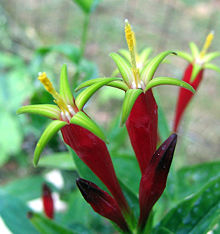User:MooseCrossingXX/sandbox
This article needs additional citations for verification. (October 2017) |
| Woodland pinkroot | |
|---|---|

| |
| Scientific classification | |
| Kingdom: | Plantae |
| Clade: | Tracheophytes |
| Clade: | Angiosperms |
| Clade: | Eudicots |
| Clade: | Asterids |
| Order: | Gentianales |
| Family: | Loganiaceae |
| Genus: | Spigelia |
| Species: | S. marilandica
|
| Binomial name | |
| Spigelia marilandica | |

| |
| US distribution by state of Spigelia marilandica | |
Background Information[edit]
Spigelia marilandica, the woodland pinkroot[1] or Indian pink, is a perennial wildflower in the Loganiaceae family that is used as ornamental plant. It flowers in June and tends to be found low moist woods, ravines, or streambanks in partial or full shade. It will grow 30–61 cm (1–2 ft) high with a spread of 15–46 cm (0.5–1.5 ft).The Spigelia Marilandica is part of the genus Spigelia, which comes from the family Loganiaceae[2]. Some of the species in Spigelia are noted to be extremely poisonous. This type of plant is a wildflower that is poisonous[3]. The flower is found in the regions of mountains, Piedmont, and coastal plains[3] of the eastern edge of Texas or the state line of Louisiana[2].
Description[edit]
The Spigelia Marilandica is a red flower with a four-sided stem, where the flower blooms and does not have petioles, meaning the leaves are directly attached to the stem. On the remaining 2 inches at the top of the arching stem, flowers are set out in cluster creating racemes. As the flowers are in racemes, there are two to twelve tubular-shaped flowers that have 5 yellow petals[3], which are pointed backward[4]. The Spigelia Marilandica creates the fruit called a capsule[3]. A capsule is produced by angiosperms, a flowering plant[5], that contains seed vessels[6]. This flower is perennial[3], meaning it can live infinitely.
Cultivation[edit]
Its flowering season is during March through May[2] and the flower prefers moist, rich woods and thickets[3]. As this flower prefers moist, rich woods and thickets it is rarer in Texas than in Louisiana[2]. This allows its native range to extend from the southern Midwest to the east of the south to north as Maryland[2]. While the Spigelia Marilandica prefers moist woods, the plant stays close to the ground allowing the flower to be part of a bush[7]. As the Spigelia Marliandica is perennial, it can survive through morning sun, full shade, droughts, slightly acid pH, sand, and loamy or clay soil[7].
Poison[edit]
The Speigelia Marilandica is categorized as a poisonous species, as it has a toxic principle called Alkaloid Spigiline[3]. All parts of this flower are poisonous if ingested. The symptoms are dim vision, vomiting, dilated pupils, twitching of the face, and culvulsions[3]. However, the Speigelia Marilandica poison does not affect hummingbirds, but instead attracts them[3].

References[edit]
- ^ USDA, NRCS (n.d.). "Spigelia marilandica". The PLANTS Database (plants.usda.gov). Greensboro, North Carolina: National Plant Data Team. Retrieved 25 November 2015.
- ^ a b c d e Longumiller, Longuhmiller, Campbell and Lynn (2018). Texas Wildflowers: a Field Guide. Austin, TX: Joe Marcus. ISBN 1477314768.
{{cite book}}: CS1 maint: multiple names: authors list (link) - ^ a b c d e f g h i "Spigelia marilandica". plants.ces.ncsu.edu. Retrieved 2019-02-12.
- ^ "Dodge, John Vilas, (25 Sept. 1909–23 April 1991), Senior Editorial Consultant, Encyclopædia Britannica, since 1972; Chairman, Board of Editors, Encyclopædia Britannica Publishers, since 1977", Who Was Who, Oxford University Press, 2007-12-01, retrieved 2019-02-12
- ^ "Capsule (fruit)", Wikipedia, 2018-10-24, retrieved 2019-02-12
- ^ "Flowering plant", Wikipedia, 2019-02-10, retrieved 2019-02-12
- ^ a b "Spigelia marilandica Indian pink (No Advance Order) from New Moon Nurseries". www.newmoonnursery.com. Retrieved 2019-02-12.
- Pink, A. (2004). Gardening for the Million. Project Gutenberg Literary Archive Foundation.
- Missouri Plants
- Kemper Center for Home Gardening
[[Category:Loganiaceae]] [[Category:Flora of the United States]]

